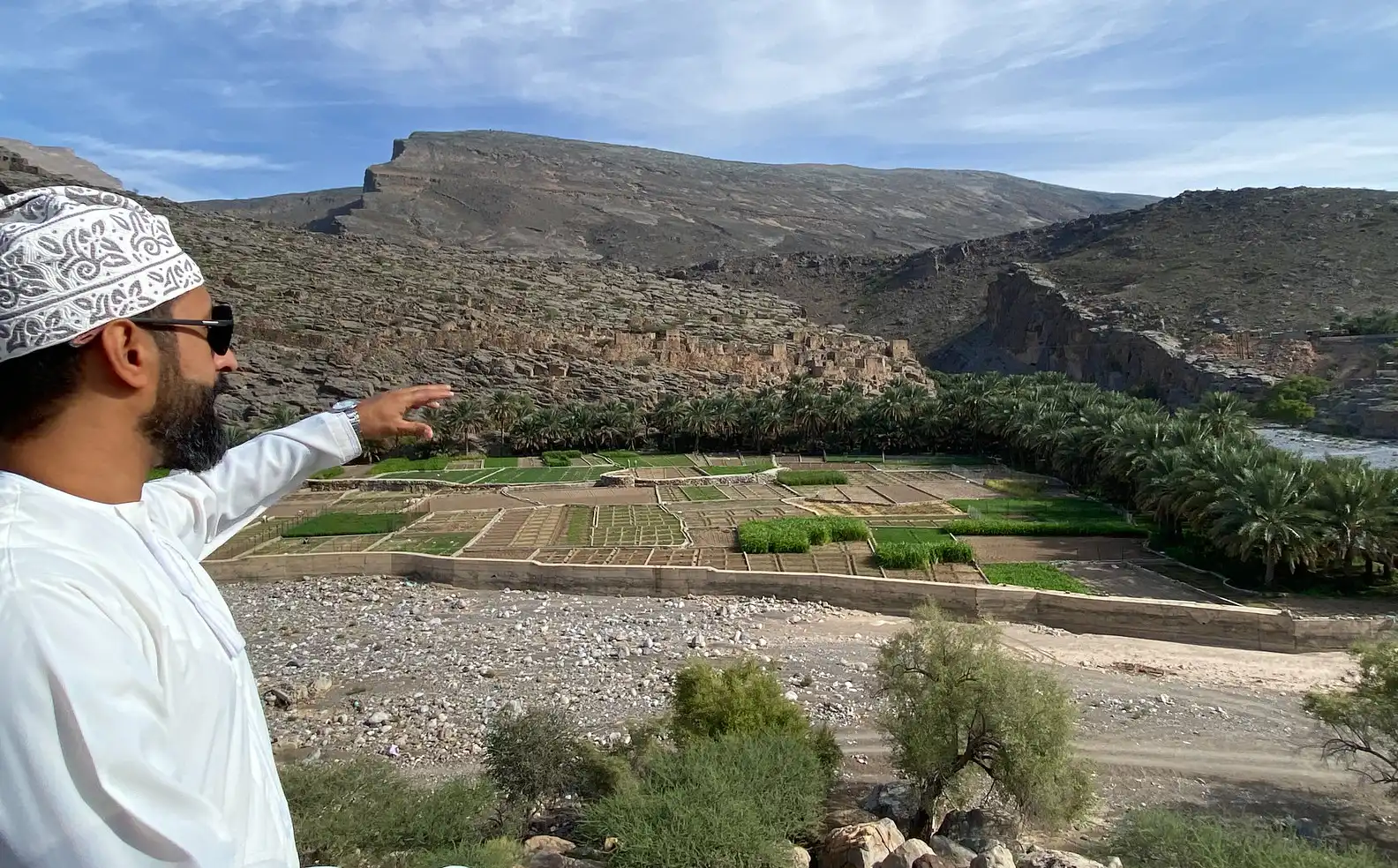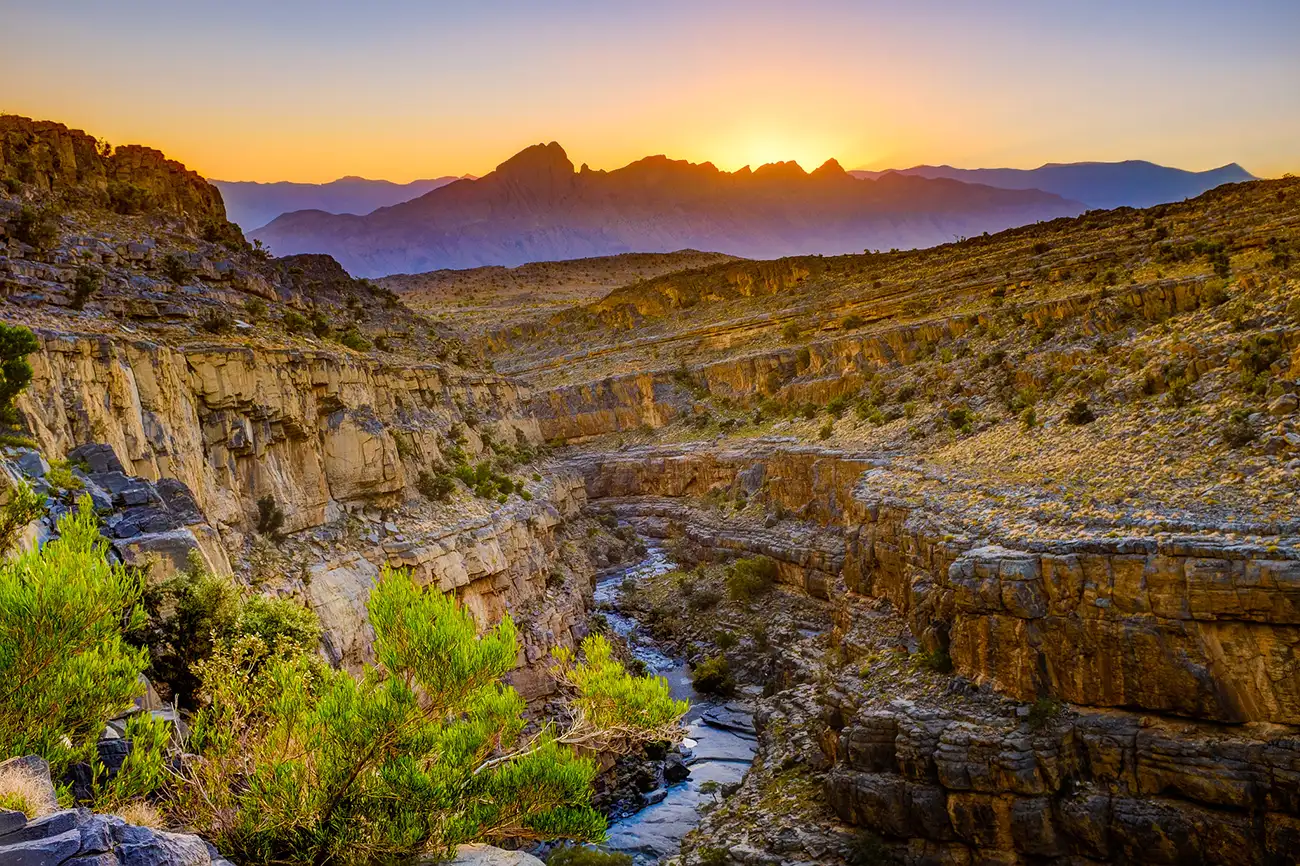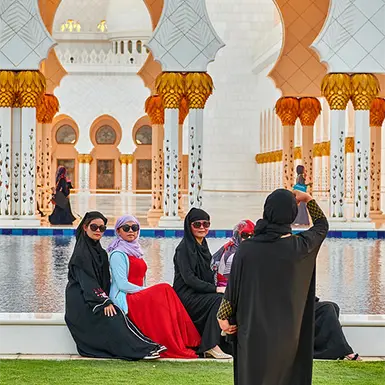The majestic Wadi Ghul, situated in the Ad Dakhiliyah Governorate of Oman, is one of the natural marvels around the Al Hajar Mountains, close to Jebel Shams. It is known as the ‘Grand Canyon of Arabia’ due to its breathtaking scenery and ability to serve as a gateway to Oman’s herculean ranges.
Wadi Ghul’s resemblance to the renowned Grand Canyon is unmistakable. Millennia of natural forces have sculpted deep, complex gorges into the landscape, creating a dramatic and striking scene that captivates photographers, hikers, and geology enthusiasts. The vast expanses and profound canyon depths ignite wonder, making this abandoned village an essential destination for Oman visitors.

Why Visit Wadi Ghul?
- A Photographer’s Paradise: Wadi Ghul’s endless and varying topographies allow for image capturing without restrictions. One can get a picture-perfect scene from every corner of the place, whether the happy golden hour casting shadows in the gorges or the serene sky with countless stars at night.
- Hiker’s Haven: This abandoned village calls out to all its adventurers as the trails with views of the canyon and the desert beyond are breathtaking. It does not matter what your level of fitness and experience is. There are leisurely strolls on the rim, medicated hikes over the edge, and demanding ones inside the canyon’s depth.
- Geological Wonder: Unique rock formations and visible geological layers draw geologists and nature enthusiasts to this village. Educational tours provide insights into the natural processes that have shaped this spectacular area, focusing on its geology and natural history.
- Cultural Connection: Visiting this abandoned village also allows for cultural immersion. The nearby towns and markets showcase the traditional Omani lifestyle, offering visitors warm hospitality and a rich historical backdrop.
- Escape into Nature: This abandoned village offers a perfect retreat from the modern world, where one can enjoy tranquility amid nature’s magnificence. The pure air, peaceful environment, and grand scale of the landscape offer a refreshing pause from everyday life’s hustle and bustle.
Exploring the Geographical Features
Nestled in Oman’s Al Hajar Mountains, Wadi Ghul is a testament to nature’s power over millennia. Known as the “Grand Canyon of Arabia,” it showcases breathtaking geological formations shaped by natural forces, offering visitors a glimpse into its dramatic terrain.
Canyon Description
- Sheer Cliffs and Steep Rock Faces: This abandoned village is famous for its towering cliffs and steep rock faces, which dominate the landscape. These formations create stunning views and highlight the rugged beauty of Oman’s terrain.
- Impressive Depth: The canyon’s depth is another feature that leaves visitors in awe. Several viewpoints allow people to gaze straight down into the gorge, offering a sense of its vastness.
- Erosion and Natural Processes: Over thousands of years, erosion has sculpted the rock layers in this abandoned village. Water erosion, particularly during rare rainfalls, continues to shape the landscape, making it a dynamic and ever-evolving natural wonder.
Depth and Scale
- Comparison with Global Landmarks: This abandoned village still impresses with its significant depth and scale while smaller than the Grand Canyon. Many compare it to famous canyons, such as the Fish River Canyon in Namibia or Tibet’s Yarlung Tsangpo Gorge.
- Measurements: This abandoned village stretches for several kilometers and drops more than 1,000 meters, making it one of the most breathtaking geological wonders in the area.
Wadi Watercourse
- Definition of ‘Wadi’: In the Middle East, “wadi” refers to a dry riverbed or valley that only fills with water during the rainy season. This place perfectly fits this definition.
- Seasonal Water Flow: This abandoned village remains dry for most of the year. However, water flows through the wadi during the rainy season, temporarily transforming it into a river. This rare water flow helps shape the canyon’s features and supports the sparse vegetation in the area.
- Exploration Opportunities: Wadi Ghul’s typically dry conditions make it ideal for hiking and exploration. Visitors can safely walk along the wadi bed, getting a close-up view of the canyon’s vast scale and geological beauty.
Historical and Cultural Significance
With its dramatic landscape and rich history, Wadi Ghul offers more than just breathtaking views. This canyon holds archaeological significance and tells the story of ancient settlements and the enduring traditions of the local people. Below, we explore its historical and cultural importance.
Ancient Settlements
Archaeological evidence suggests that Wadi Ghul has been home to human settlements for centuries. At the base of the canyon, near its towering cliffs, lies the now-abandoned village of Ghul. This village is a testament to the area’s ancient past, providing insights into the lives of the people who once thrived in this rugged terrain. The remnants of stone houses, terraced farms, and other structures offer a glimpse into how these communities adapted to life in such a challenging environment.
The Village of Ghul
The village of Ghul, located at the foot of Wadi Ghul, is an essential part of the canyon’s history. Though abandoned today, its stone houses and terraced farming methods are still visible, showing how its residents utilized the natural landscape for agriculture. These terraced farms were carved into the slopes of the canyon, allowing the villagers to grow crops in an otherwise harsh, arid environment.
The old stone houses, built using local materials, demonstrate the ingenuity of the early inhabitants. They constructed these homes to withstand the harsh conditions of the canyon, using thick walls to protect themselves from extreme temperatures. Today, visitors to this abandoned village can explore these remnants, gaining a deeper understanding of the region’s historical lifestyle.
Local Culture and Traditions
Although residents have abandoned the village of Ghul, the surrounding communities continue to uphold traditional practices passed down through generations. Agriculture remains a crucial part of life in the area, with local farmers still using terraced farming techniques similar to those seen in the village of Ghul. The local population has developed an intimate knowledge of the land, cultivating crops and sustainably raising livestock.

Outdoor Activities
One of the attractions in Wadi Ghul is that it is a beautiful place and a center for multiple outdoor activities. Any adventurer can go deep into the canyon’s spectacular geologic formation in many ways, from trekking to camping. Below are the top outdoor activities to enjoy at this abandoned village:
Trekking and Hiking
- Popular Routes: The Balcony Walk is among the most popular treks of Wadi Ghul, allowing travelers to see incredible sights of the steep edges of the canyon and the vegetated areas surrounding it. Thus, we suggest this trail for the visitors who wish to appreciate this abandoned village from his perspective.
- Difficulty Levels: The views of the balcony walk are easy for most hikers who have done this trek. However, more challenging routes do exist for more experienced trekkers. These long upward and sloping paths would please thrill seekers seeking an adventurous and physically strenuous activity.
- Gear and Precautions: Due to the arid climate and rocky paths, hikers should bring sturdy hiking boots, plenty of water, and sunscreen. It’s essential to start early in the morning to avoid the midday heat, and carrying a map or GPS device is advised for navigation.
Rock Climbing
- Rock Climbing Opportunities: This abandoned village offers some areas with steep rock faces suitable for rock climbing. While it may not be a global rock-climbing hotspot, adventurous climbers can find challenging climbs along the canyon’s rugged cliffs.
- Adventure Sports: Wadi Ghul’s cliffs and rocky terrain provide an ideal setting for adventure sports. However, it’s essential to check with local guides or adventure companies to ensure safety and suitability for climbing activities.
Camping
- Camping Spots: Wadi Ghul offers excellent camping opportunities, especially for those who enjoy camping in the wilderness. The rim of the canyon and areas near the base of the wadi are popular spots to set up camp and enjoy the starry night sky.
- What to Bring: Campers should come prepared with a sturdy tent, sleeping bag, and enough supplies for an overnight stay. Given the rocky terrain, bringing a comfortable sleeping mat is wise.
- Best Camping Spots: Some of the best camping spots around this abandoned village are near the Balcony Walk trailhead and at various points along the canyon rim. These areas offer panoramic canyon views and are perfect for watching the sunrise or sunset.
Flora and Fauna
Wadi Ghul is famous for its dramatic landscapes and unique plant and animal life that thrive in harsh, arid conditions. Even though the places are quite dry, some species have been able to adapt to the canyon’s harsh physiographical features and scarce water supply.
Vegetation in Wadi Ghul
- Hardy Shrubs: The dry and rocky landscape in this abandoned village has many resilient plant species that have adapted to these conditions. Hardy shrubs, especially those adapted to arid conditions, also cover the region; though few, they provide crucial greenery.
- Acacia Trees: You will mostly find Acacia trees in the lowlands of Wadi Ghul, where there is enough moisture. Their extensive roots help them access water from under the ground, making this dry climatic region favorable.
- Other Vegetation: A few grasses and small bushes grow on the shady sides and in small cracks in the canyon. Although not many of these plants are functional in the ecosystem, they offer food and housing to some animal populations.
Wildlife
- Mountain Goats: Visitors to Wadi Ghul frequently spot mountain goats. These agile animals easily navigate the cliffs and rocky terrain, making them a common sight in the canyon.
- Birds of Prey: Eagles and falcons often soar above this abandoned village. The high cliffs provide an excellent habitat for these birds of prey, who hunt for smaller animals in the valley below.
- Smaller Mammals: Some smaller mammals, like foxes and even rodents, have colonized the extremes of this abandoned village. They probe into rocky shelters and feed on a meager diet of any plant life and moisture in that region.
Climate and Best Time to Visit
The climate in Wadi Ghul can be quite extreme, with hot days and chilly nights. Understanding the weather patterns will help you prepare for your visit and ensure a comfortable and enjoyable experience.
Seasonal Weather
- Summer Heat: During summer, temperatures in Wadi Ghul can rise significantly, making outdoor activities difficult. Daytime temperatures can easily exceed 40°C (104°F), although they drop sharply at night.
- Cool Nights: Even after a scorching day, temperatures in Wadi Ghul plummet at night. This sudden shift can catch visitors off guard, so it’s important to pack layers of clothing if you’re staying overnight.
- Winter Conditions: Winter in this abandoned village brings cooler daytime temperatures, which are more pleasant for outdoor activities. However, nights can get quite cold, especially at higher altitudes within the canyon.
Optimal Seasons to Visit
- Autumn: The ideal time to visit Wadi Ghul is October to November. The cooler temperatures make trekking and camping more enjoyable. During this season, days are mild, and nights are comfortable for overnight stays.
- Spring: Another great time to explore Wadi Ghul is from March to April. The weather is warm but not too hot, and the landscape may feature more greenery as desert plants bloom after the winter rains.
- Avoid Summer: It is best to avoid visiting this abandoned village in summer, as the extreme heat can make outdoor activities uncomfortable and even dangerous.
Photography and Scenic Spots
For those who love photography, the beauty of Wadi Ghul is one place that will give them a run for their money in capturing beautiful sceneries. The climbing activity in the region is a bonus due to its high cliffs and canyons as well as the breathtaking views of Oman. Here are some photography sites you shouldn’t miss when visiting this abandoned village:
Key Photo Opportunities
- Balcony Walk: A famous hiking path known as the Balcony Walk has several viewpoints that are favorable for photography. The upside of the trail gives gorgeous canyon shots, making it one of the favorite places for taking dramatic photos. Morning or evening shoots are great since the soft light captured adds depth and beauty to the landscape.
- Canyon Rim: One can get good pictures over the canyon by obtaining all the angles on a wide-angle photo. You can capture the best views by standing in the canyon at dawn or sunset when the bright sunlight paints the rocks in picturesque shades of red.
Panoramic Views
- Canyon and Mountain Vistas: Several viewpoints along Wadi Ghul offer spectacular panoramic views of the canyon and Al Hajar Mountain range. These popular sweeping views make this spot a great attraction for those passionate about the outdoors and photographers interested in Oman’s expansive and rugged landscapes.
Nearby Attractions
Most Wadi Ghul tourists also visit places of interest that promise equally breathtaking views and cultural importance. Some of the best places to visit include but are not limited to the following:
Jebel Shams
- Oman’s Highest Peak: Wadi Ghul, Jebel Shams, which lies nearby, is the tallest in Oman and is usually loved by climbers and photographers. Most tourists combine their Wadi Ghul tour with a visit to Mount Shams to experience the spectacular sights of the place.
- Stunning Views: Jebel Shams has a breathtaking view of the canyon beneath that depicts the wondrous scenic view of Wadi Ghul, amongst other features of nature in the region. It is an ideal location to take pictures using a wide-angle lens.
Wadi Nakhr
- Neighboring Wadi: People often refer to Wadi Nakhr alongside Wadi Ghul, as both canyons are in the same region. Jebel Ghul is, however, comparatively better for those seeking to hike and take photographs.
- Distinct Features: Wadi Nakhr incorporates much vertical rock and a cut-off width, which gives it a unique yet gorgeous view. For people coming to the area on canyon exploration, both are two of their trips.
Other Attractions
- Ancient Villages: The area around Wadi Ghul contains ancient villages with old stone houses and terraced farming systems. These villages provide a unique glimpse into Oman’s cultural history and serve as excellent spots for artistic photography.
- Forts and Cultural Landmarks: Nearby forts and historical sites also add a layer of history to your visit. These landmarks help you understand the region’s heritage while offering more photography opportunities.
How to Reach Wadi Ghul
Starting a trip to Wadi Ghul allows you to explore the stunning natural landscapes of Oman. A well-planned tour from either the vibrant city of Muscat or the historic town of Nizwa ensures a smooth travel experience.
Directions from Muscat or Nizwa
- From Muscat: A 2.5 to 3-hour drive along Route 15 takes you to Wadi Ghul. This route is scenic and well-maintained. While regular vehicles suffice under typical conditions, a 4WD enhances your ability to explore off-road areas and navigate rougher terrain near the canyon.
- From Nizwa: Traveling from Nizwa to the canyon lasts about 1.5 hours. The roads maintain good conditions but may require a 4WD as you approach the canyon, especially during the rainy season when paths become slippery.
Public Transport Options
- Availability: Limited public transport options challenge reaching the canyon without a personal vehicle.
- Guide or Driver: For those without cars, hiring a guide or driver is advisable. This service is available in Muscat or Nizwa, where tour operators are well-versed in the region and enhance your travel experience with local insights.
Safety and Travel Tips
Navigating Wadi Ghul presents exhilarating challenges. Here are some key tips to help you have a safe and enjoyable visit.
Trekking Safety
- Stick to Marked Trails: Always follow marked trails to avoid getting lost and reduce environmental impact.
- Hydration is Key. You can get dehydrated quickly because of the dry climate and high temperatures. Carry more water than you think you’ll need.
- Monitor Weather Conditions: Stay alert to sudden weather changes. Although flash floods are rare, they pose risks, so check the weather forecast before your outing.
Considerations for High Altitudes
- Acclimate Appropriately: If you’re heading up to the higher elevations near Wadi Ghul and Jebel Shams, take some time to acclimate to avoid altitude sickness.
- Recognize Altitude Sickness Symptoms: Familiarize yourself with symptoms like headaches, nausea, and dizziness. If you feel unwell, head to a lower altitude and seek medical help immediately.
Environmental Responsibility
- Avoid Littering: Ensure you carry out all your trash. Littering spoils the natural beauty and threatens wildlife.
- Respect Wildlife: Respect the wildlife by keeping a safe distance, not feeding the animals, and being careful not to disturb their natural habitats.
- Adhere to ‘Leave No Trace’ Principles: Maintain the pristine condition of the environment to allow future visitors to enjoy the same beauty.
Accommodations Near Wadi Ghul
Visitors to Wadi Ghul will find various accommodation options that cater to different preferences, whether seeking comfort in nearby lodges or an adventurous camping experience.
Lodges and Guesthouses
- Al Hamra: Located a short drive from Wadi Ghul, Al Hamra offers a range of guesthouses and lodges. These accommodations are perfect for those who want a more comfortable stay while exploring the region. Many guesthouses in Al Hamra provide traditional Omani hospitality, with beautiful views of the surrounding mountains and valleys.
- Jebel Shams: For those wanting to stay closer to Oman’s highest peak, lodges on Jebel Shams offer a cozy base for exploring the mountain and Wadi Ghul. These lodges provide modern amenities and often include stunning canyon vistas below.
Camping
- Canyon Camping: Adventurous travelers can camp near Wadi Ghul and enjoy its rugged beauty. Several designated camping spots are available for those who want to enjoy a night under the stars. Camping in the canyon allows you to experience the area’s serenity and magnificent night skies, with the towering cliffs of the canyon as your backdrop.
- What to Bring: If you’re planning to camp, bring sturdy tents, warm sleeping bags, and enough food and water to last throughout your stay. It’s also advisable to check weather conditions to avoid extreme temperatures or unexpected rainfall.
Local Cuisine and Dining
Exploring the natural beauty of Wadi Ghul can work up an appetite. Fortunately, nearby villages like Al Hamra offer various dining options where you can enjoy traditional Omani dishes after hiking and sightseeing.
Dining Options
- Traditional Omani Restaurants: In Al Hamra, several local eateries serve delicious Omani cuisine. Dishes like shuwa (slow-cooked lamb) and majboos (spiced rice with meat or chicken) are popular for visitors looking to taste authentic flavors. These restaurants provide a relaxed atmosphere where you can unwind after a long day of exploring.
- Café and Casual Dining: There are also casual dining spots and cafes in the area, offering lighter meals, snacks, and refreshments. These are great for a quick bite or a relaxing coffee break between your canyon adventures.
Picnic Spots
- Scenic Picnic Areas: Wadi Ghul offers several picturesque picnic spots for those who prefer a more laid-back dining experience. Pack your lunch and head to one of the scenic viewpoints around the canyon. Whether you’re enjoying a simple meal or a full spread, the breathtaking views of the canyon provide the perfect backdrop.
- Canyon Rim: The canyon’s rim is one of the most popular places for a picnic. You can enjoy your meal while taking in the expansive views of the canyon below and the mountains in the distance.
Wadi Ghul in Popular Culture
Wadi Ghul has succeeded greatly as a sought-after destination for explorers and adventurers alike. Thanks to its beautiful views and colorful outdoor activities, it attracts visitors from all continents.
Tourism Growth
More and more tourists from every region are interested in Wadi Ghul. The breathtaking landscape of the canyon, combined with some extreme activities such as hiking, trekking, and even rock climbing, makes its visitors more willing to experience all the resources available in the wilderness. The rise of the voyager looking for distant and especially remote areas explains why the brilliant yet virgin beauty of the canyon provides an insight into the natural aspects of the country that is Oman.
Featured in Media
Several documentaries, articles, and media coverage have also highlighted Wadi Ghul’s picturesque and strange cultural aspects. These features have enhanced the canyon’s image as an attractive site in Oman, encouraging visitors to come and experience the thrilling landscapes.
Conclusion
Every traveler who visits Wadi Ghul will find something unique. The cliffs and deep gorges are a perfect setting for everyone, from photographers to hikers and people who love nature. And, of course, apart from such idyllic scenery, there are also extreme sports, such as rock climbing and camping out in the open. Tribal settlements with old traditions are also in the neighborhood, which explains the abundant history of this place.




